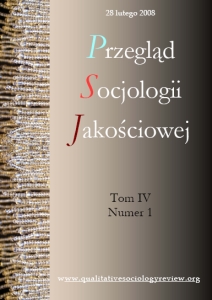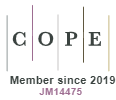Dotyk i wymiana gestów jako element wytwarzania więzi emocjonalnej. Zastosowania socjologii wizualnej i metodologii teorii ugruntowanej w badaniu interakcji zwierząt i ludzi
DOI:
https://doi.org/10.18778/1733-8069.4.1.04Słowa kluczowe:
Interakcje ludzi i zwierząt, socjologia wizualna, nagrania wideo, analiza danych wizualnych i metodologia teorii ugruntowanej, intencjonalność, intersubiektywność, ciało, cielesność, dotyk, teoria ugruntowana, asocjacje społeczne, zabawaAbstrakt
Artykuł dotyczy problematyki analizy interakcji pomiędzy ludźmi a zwierzętami domowymi. W badaniach tego problemu analizowano transkrypcje nagrań wideo interakcji zwierząt i ludzi. Obserwacje wymian dotyków i gestów pozwoliły zrekonstruować społeczne rytuały (powitania i pożegnania) i inne społeczne formy asocjacji (zabawa, spontaniczne wyrażanie emocji, kąpiele, układanie do snu, spacery, walki na spacerach, pobłażliwe karcenie, podawanie leków, ustanawianie formy interakcji), które wytwarzają emocjonalne i społeczne więzi. Analiza danych wizualnych daje możliwość badania cielesności i bezpośrednich interakcji ciał w wymiarze sekwencyjnej wymiany gestów jako podstawowego wymiaru wytwarzania emocjonalnej i społecznej więzi i ostatecznie tzw. „tożsamości rodzinnej". Jako metody analizy danych użyto procedur metodologii teorii ugruntowanej.
Pobrania
Bibliografia
Belk, Russel W. (1996) “Metaphoric relationship with pets.” Society and Animals 4(2): 121-145.
Google Scholar
DOI: https://doi.org/10.1163/156853096X00115
Blumer, Herbert (1969) Symbolic Interactionism. Perspective and Method. Berkeley, Los Angeles, London: University of California Press.
Google Scholar
Cain, Ann (1983) “A study of pets in the family system.” S 72-81 w New perspectives on our lives with companion animals, (Red.) A. H. Katcher & A. M. Beck. Philadelphia: University of Pennsylvania.
Google Scholar
Cain, Ann (1985) “Pets as family members.” Marriage and Family Review 8(3/4): 5-10.
Google Scholar
DOI: https://doi.org/10.1300/J002v08n03_02
Carmack, Betty J (1985) “The effects of family members and functioning after the death of a pet.” S. 149-162 w Pets and family, (Red.) M. B. Sussman. New York: Haworth.
Google Scholar
DOI: https://doi.org/10.4324/9781315784656-11
Charmaz, Kathy (2006) Constructing Grounded Theory: A Practical Guide Through Qualitative Analysis. London: Sage.
Google Scholar
Doi, Takeo (1982) The Anatomy of Dependence. Tokyo: Kodansha.
Google Scholar
Glaser, Barney and Anselm, L. Strauss (1967) Discovery of Grounded Theory : Strategies for Qualitative Research. Chicago: Aldine.
Google Scholar
DOI: https://doi.org/10.1097/00006199-196807000-00014
Glaser, Barney (1978) Theoretical Sensitivity. San Francisco: The Sociology Press.
Google Scholar
Heath, Christian (1997) “Using video: analysing activities in face to face interaction.” S 183-200 w Qualitative Research: Theory, Method and Practice, (Red.) David Silverman. London: Sage.
Google Scholar
Flynn, Clifton P. (1999) “Animal Abuse in Childhood and Latter Support for Interpersonal Violence in Families.” Society and Animals 7(2): 161- 172.
Google Scholar
DOI: https://doi.org/10.1163/156853099X00059
Goode, David (2007) Playing With My Dog Katie. An Ethnomethodological Study of Canine – Human Interaction. Purdue University Press.
Google Scholar
Knoblauch, Hubert (2004) Die Video-Interaktions-Analyse, sozialersinn, 1: 123-138.
Google Scholar
DOI: https://doi.org/10.1515/sosi-2004-0107
Knoblauch, Hubert / Schnettler, Bernt / Raab, Jürgen / Soeffner, Hans-Georg (Red.) (2006) Video Analysis: Methodology and Methods. Qualitative Audiovisual Data Analysis in Sociology. Frankfurt am Main, Berlin, Bern, Bruxelles, New York, Oxford, Wien.
Google Scholar
Konecki, Krzysztof (2000) Studia z metodologii badań jakościowych. Teoria ugruntowana. Warszawa: PWN.
Google Scholar
Konecki, Krzysztof 2005) Ludzie i ich zwierzęta. Interakcjonistyczno-symboliczna analiza społecznego świata właścicieli zwierząt domowych. Warszawa: Scholar.
Google Scholar
Konecki, Krzysztof (2005a) “Wizualne wyobrażenia. Główne strategie badawcze w socjologii wizualnej a metodologia teorii ugruntowanej.” Przegląd Socjologii Jakościowej, Tom I, Numer 1. Pobrany Miesiąc 10, Rok 2007 http://www.qualitativesociologyreview.org/PL/Volume1/PSJ_1_1_Konecki.pdf
Google Scholar
DOI: https://doi.org/10.18778/1733-8069.1.1.04
Leathers, Dale (2007) Komunikacja Niewerbalna. Warszawa: PWN.
Google Scholar
Liberman, Kenneth (2004) Dialectical Practice in Tibetan Philosophical Culture: An Ethnomethodological Inquiry into Formal Reasoning. Lanham, Md.: Rowman & Littlefield Publishers, Inc.
Google Scholar
Mitchell, Robert W. and Nicholas, S. Thompson (1991) “Projects, routines, and enticements in dog – human play.” S. 189–216 w Perspectives in Human Ethology, (Red.) Paul P.G. Bateson & Peter H. Klopfer. New York: Plenum Press.
Google Scholar
Rancew-Sikora, Dorota (2007) Analiza konwersacyjna jako metoda badania rozmów codziennych. Warszawa: Trio.
Google Scholar
Raupp, Carol (1999) “Treasuring, Trashing or Terrorizing: Adult Outcomes of Childhood Socialization about Companion Animals.” Society and Animals.7(2): 141-159.
Google Scholar
DOI: https://doi.org/10.1163/156853099X00040
Sanders, Clinton (1999) Understanding Dogs: Living and Working with Canine Companions. Philadelphia: Temple University Press.
Google Scholar
Scott, Byron (1973) How the Body Feels. New York: Ballantine.
Google Scholar
Silverman David (2005) Doing Qualitative Research. A Practical Handbook. London, Thousands Oaks, New Delhi: Sage.
Google Scholar
Silverman David (2007) A Very Short, Fairly Interesting and Reasonably Cheap Book about Qualitative Research. Los Angeles, London, New Delhi, Singapore: Sage.
Google Scholar
Silverman David (2007a) Interpretacja danych jakościowych. Metody analizy rozmowy, tekstu i interakcji. Warszawa: PWN.
Google Scholar
Suchar, Charles (1997) “Grounding Visual Research In Shooting Scripts.” Qualitative Sociology 20(1): 33-55.
Google Scholar
DOI: https://doi.org/10.1023/A:1024712230783
Strauss Anselm and Juliet Corbin (1990) Basics of Qualitative Research. London: Sage.
Google Scholar
Pobrania
Opublikowane
Jak cytować
Numer
Dział
Licencja

Utwór dostępny jest na licencji Creative Commons Uznanie autorstwa – Użycie niekomercyjne – Bez utworów zależnych 4.0 Międzynarodowe.














